If you’re having trouble pricing accounting and bookkeeping services for your fixed-price mandates, you’re not the only one (and you’ve come to the right place).
Customer expectations are changing, and they are now more insistent than ever on upfront pricing. This is pushing accountants like you to ditch hourly rates in favor of a new pricing strategy and method, which sometimes creates confusion about how to set your accounting services fees.
As someone who has priced 1000+ engagements while running my own small business bookkeeping & accounting firm, this post will discuss how to price bookkeeping and accounting services for your upfront fixed-price mandates and will provide four easy steps that I recommend you follow to establish your prices.
Let’s get started.
Table of Contents
- Why is Pricing Accounting Services Difficult?
- Fixed vs. Value Pricing
- Pricing Accounting Services – 4 Steps to Follow
Why is Pricing Accounting Services Difficult?

For as long as many can remember, accountant fees have always been based on the billable hour as a pricing strategy.
This method made a lot of sense to most certified public accountants since it’s exceptionally easy to calculate your return on investment. Just let the clock run and you know what your margin is going to be on each and every hour that you spend working.
Now, this method does come with some disadvantages (which we won’t go into here), many of which are causing many firms to re-think their pricing strategy.
Today, the trend is moving heavily towards offering small business clients certainty upfront in the price they’ll receive before the service is delivered. Though this has presented difficulties in pricing for accountants. Many accounting firms that I’ve spoken with have had bad experiences trying to adopt fixed pricing and value pricing approaches.
Why?
Likely because it’s a completely different approach. It takes a bit more strategy & thought than the billable hour as well as some basic education in price theory. In basic bookkeeping and accounting, not all hours are created equal. When you combine basic bookkeeping services provided with CFO guidance, financial reports, tech implementation, year-end tax returns preparation, tax return preparation fees, and strategic advisory you have a wide range of value being provided which can alter your approach.
Fixed vs. Value Pricing

The following are the two strategies to consider when determining how much does an accountant charges upfront, since your approach will differ depending on which path you go with: fixed pricing and value pricing.
Fixed Pricing
With fixed pricing, you are essentially setting up a service menu and attaching a fixed price to them across the board. As a simple example, this means that year-end tax return preparation fees will be billed the same way for Client A and for Client B.
In a value pricing approach, your accountant’s fees will differ from client to client depending on the situation. The tax preparation fees for Client A may be different than the year-end tax preparation fees for Client B, even if the service is identical.
The big benefit of fixed-pricing is that you just need to quote once and use those costs each time a small businesses client requests a service. The implication is that this method is a lot faster to price your mandates and is, therefore, a lot more scalable. If you have a ton of sales inquiries, it may make more sense to implement this approach if your main goal is rapid growth and cash flow.
Value Pricing
When it comes to value pricing, due to the fact that you have to price each client individually based on their small business, like the tax returns preparation example we stated above, it’s naturally a more time-consuming process. The benefit here though is that you can typically extract a higher price from the client than with a fixed accountant fees approach. If done right, value pricing should therefore result in higher margins.
At times, it may be an option to have a hybrid approach at your firm. Some of your highly commoditized services (ex: tax preparation or basic bookkeeping services) can be perhaps menu-priced and some of your advisory services (cash flow forecasting, review of financial statements) can be value-priced, for example.
Now that we have the basics out of the way, below you’ll find a few simple steps to follow when pricing accounting services and bookkeeping services at your firm in order to deliver your prices upfront.
Pricing Accounting Services – 4 Steps to Follow
Step 1 – Chat with Your Client

Thanks to some of the marketing for accountants strategies you’ve leveraged, you’re now ready to chat with a prospective client.
Before you can even think about pricing accounting services on your mandates, you need to have an in-depth conversation with your client in order to assess your client’s financial and business needs. Put yourself in their shoes as small business owners, and work to deliver a solution they need.
Key point: Ask open-ended questions, and avoid assumptions. Business owners are different. Some hate accounts payable, some hate accounts receivable. Others despise simply reconciling their bank accounts and credit card accounts. Dive in and determine where the pain lies, so you can help business owner solve the issue. If they hate accounts payable, and it’s not a service you provide, point them toward someone who provides bill pay services.
The price that you’ll set will be based on your service offer which has to explicitly address the needs and pain-points of the small business owners identified in the meeting with your client.
Offering something that is not completely aligned with your client’s business needs is a surefire way of getting your proposal denied.
For example, you might be prioritizing advisory services, but if the client’s books are a mess you’ll need to start with an improved chart of accounts, accounting software cleanup, then basic bookkeeping services.
In that case, you can’t offer a cash flow analysis when they don’t have their chart of accounts properly organized in the first place.
Developing good discovery call questions is key in this step. Spend some time researching these kinds of questions to properly establish your client’s needs in order to outline the additional services that are required.
Step 2 – Define Your Scope

After you understand your client’s needs, you’ll need to define your scope of work before you set your prices.
In a billable hour approach with per hour pricing, you let the clock run and your price is based on the time you spent. You send out an invoice afterwards and hope that you don’t have to deal with any write-downs. Here, if you go out of scope, well, you keep charging for the time that you spend.
This is radically different with upfront pricing. If you provide a price upfront, then you want to make sure that each minute that you spend on the mandate is something that you have explicitly agreed to work on. If not, then you may find yourself in an unprofitable mandate. As such, defining your scope of work becomes incredibly important.
Monthly Bookkeeping Services Example
For example, compare these 2 scopes in bookkeeping pricing.
Scope 1: Monthly bookkeeping services for $300 per month
Scope 2: Monthly bookkeeping services for $300 per month (includes monthly bank and credit card reconciliation of up to 100 transactions per month on a cash-basis with a 4 week month-end close)
For the client accounting services in scope #1, you may get caught in a situation where you start the service at 100 transactions per month in the bookkeeping service. But then find yourself in a position handling a significantly higher per month amount of bank accounts and transactions down the road. Since your agreement doesn’t specify what is and what is not included in monthly bookkeeping services, it’s hard for you to increase your price without potentially souring the relationship. The burden is on you to make your service clear as basic bookkeeping services per month can have a wide range of outcomes.
By contrast, scope #2 is a lot more clear, and to be honest, you can even better clarify other areas of the monthly bookkeeping services process in order to improve the scope of work (ex: which schedules you’ll maintain, how you reconcile bank accounts, credit cards, etc).
Another area to be clear within the bookkeeping service scope is how many bank accounts and credit cards need to be reconciled. Don’t leave yourself a big onboarding headache. Take the time initially to understand the chart of accounts, and bank and credit card accounts you’ll be working with.
The one big trick with fixed pricing and value pricing for a bookkeeping service is really all about defining your service offering in advance. You should not present a price without an adequate definition of the work that you’ll be providing per month. As with the monthly bookkeeping services example above, one of the keys is finding a way to your ongoing per month services.
Define the Scope
Essentially, whether in bookkeeping pricing, tax services pricing, or any other service, you need to know in advance exactly how you will deliver the work. This means that you need to spend the required time upfront with your small business client to understand their situation well enough to be able to define your scope per month clearly (see Step 1). If you aren’t in a position to define your scope clearly, then you likely don’t understand the situation well enough to be able to price it.
I would much rather take more time upfront to determine what needs to be done than rushing into an engagement riddled with scope creep issues. How you price bookkeeping needs to align with a successful deliverable for both parties.
I believe one of the main challenges that accountants are having moving to an upfront pricing method is poorly defining their scope of work per month. Create parameters wherever you can. This is easier in transactional items like accounts payable, a tax return, or tax return preparation, but all additional services should have limitations.
Financial Reports Example
Another area to consider when defining scope of services is within financial reports. When providing financial statements, are you on the same page as your client?
Some business owners want a simple income statement and balance sheet with their financial statements. Others may expect a detailed report on their cash flow, and details on why the balance sheet looks the way it does. Beneath all of that, the client’s bookkeeping needs per month may require extra time before financial statements are delivered.
Your services agreement should include a list of which financial statements will be provided, and how often they will be delivered. If you’re providing an income statement and balance sheet, let them know what day of the month to expect to receive their financial data so that you can get them ready for the income tax return preparation following that.
Step 3 – Establishing Pricing

Contrary to the billable hour when you charge per hour, establishing your accounting fees will require one thing to be done in advance: knowing your costs to deliver the service.
You should not deliver an upfront fixed price unless your average cost is known. This is where steps 1 & 2 above are critical.
First, you need to understand your client’s needs.
Then, you need to turn those needs into a scope of work.
If you do that properly, you should then be able to forecast the amount of time you think it will take for that service to be delivered and therefore the accounting costs per month associated with that service.
Note the difference between doing this and with the billable hour.
One is a forecast of your costs (needed for upfront fixed pricing) and the other is looking at your costs per month after they have already been incurred and then billing clients out hoping that the small business client will pay them.
Here is a look at how you will include the forecasted accountant cost into your price calculations when utilizing the 2 pricing methodologies that have been previously explained.
Setting Your Prices – Fixed Pricing
This method is less dependent on the unique situation of each and every one of your clients and is more dependent on the pricing that you have established beforehand. You’ll need to set a menu of all of your additional services and then attach a price to each one.
Most of your recurring services may be similar, so you can get an estimated amount of time it takes to deliver that service to establish your costs per month upfront and then identify your desired margin to arrive at a fixed price per month for that service.
Your menu of prices can consist of individual services or a bundle of services (ex: financial statements, bill pay, accounts receivable, tax preparation fees for tax planning, accounts payable, accounting software, etc).
Then you also need to quantify the volume included within the services. This could mean determining how many bank accounts, credit card accounts, or number of transactions in a month.
Keep Step 2 in mind here. You will absolutely need a well-defined scope for this method to make sense. Otherwise you’ll bite into your margins if scope creep appears.
Is this my favourite method of pricing? Not especially since it looks at your costs and applies a margin to arrive at your price. This means that you’re not taking into account the uniqueness of each situation and what a customer is actually willing to pay.
But I do think it makes sense for some services. For instance, if you have a ton of year-end personal tax returns, something that’s highly commoditized, I think it could make sense to churn those out based on menu pricing.
Setting Your Prices – Value Pricing
Value pricing takes a bit of a different approach compared to fixed pricing. In my opinion it is the most difficult method to master. If done right though, your margins will thank you.
Here, every single price that you offer is going to be different and will take into account the uniqueness of that particular situation. It also takes into account that different people are willing to pay different prices for the exact same thing.
Your job is to determine what you think that person will pay.
In order to help with this, Step 1 becomes incredibly important. In the conversation with your client, you’ll have to uncover and establish value with well-crafted questions. Just Google something like “value pricing questions” to see what kind of interview questions help.
By the end of that conversation, you should work on your scope in Step 2, define your service offer and try to attach a price to it.
Again, you are trying to figure out what you think your small business client would pay.
Accountants hate this, because it’s not based on a formula.
Want to know what I do?
I literally pick a number out of thin air based on feelings.
Yup, you heard that correctly. Literally plucking a number from the sky. It’s horribly uncomfortable at first, but like anything else, with practice, you get better.
There is actually no formula for trying to determine what someone is willing to pay per month. The more you establish value in Step 1, the easier your job will be in demanding a higher price per month.
The good thing about this method is that it makes you put yourself in the shoes of business owners to see if this price per month makes sense for them. It takes into account their unique situation. And only then do you compare that price to your forecasted costs per month to see if it makes sense for you.
See the difference?
Fixed-pricing looks at your costs in advance and applies your desired margin and voila, you have your price per month. Whether or not it makes sense for your small business client or not is another story.
Value pricing is the opposite.
With value pricing, you look at your client’s situation first, determine what they need, come up with the price that you think you’ll pay per month, and then as the last step, you compare it to your own costs. It takes time to become comfortable here. You will notice services like tax preparation are simpler to define while advisory services leave more potential for gray areas.
As it’s quite difficult to hit the bull’s eye with the exact right price per month, creating pricing options (ie. a range of services for a range of prices) is exceptionally helpful here.
And lastly, defining your scope per month is, again, incredibly important.
If you want to master this method of pricing, I highly suggest reading Ron Baker’s book, “Implementing Value Pricing”, which I recommend in my post on the best books for accounting firms looking to modernize.
Step 4 – Cement an Agreement

This is a critical step when it comes to pricing accounting services in many firms. Don’t just stop at Step 3.
Once you have arrived at your price for a particular mandate, the next step is to have a mutual agreement in place that documents your understanding of the scope of work and price per month.
Sure, you could go ahead and do this in a Word document. But let’s face it, modern accounting firms these days don’t do that. It’s sloppy, takes time if you’re doing a lot of them and quite frankly, looks unprofessional.
My number one choice for easily creating proposals and engagement letters in seconds? Practice Ignition.
Small disclosure, the link above is an affiliate link, which means I would earn a commission if you sign up with them, but in a moment you’ll see that I’ve actually been a huge believer in this app since inception of the company.
A Bit of History on Why I Like It
I used to create engagement letters myself in Word from when I started my firm until I ran into issues with wasted time, unprofessional looking proposals and incorrect information being copied over my templates. It was so bad that it caused me to scour the internet for a solution and luckily I stumbled across Practice Ignition when the company first started in 2013. In fact, I was actually proudly one of Practice Ignition’s first customers on the platform back in 2013.
I do think they understand the typical pain points of pricing accounting services and the process around it as their founder, Guy Pearson, was a former firm-owner himself (with one of the first cloud accounting firms in the world). He and the team are all about automating many of those administrative processes surrounding pricing, proposals, engagement letters and payments. Professional proposals also help to keep your accounts receivable to a minimum by stating when accounts receivable are due.
How Does it Work?
Regarding Practice Ignition, here’s how I would recommend getting started if you want to play around with it.
First, you’ll load up your engagement letter into Practice Ignition as a template under the “terms” section.
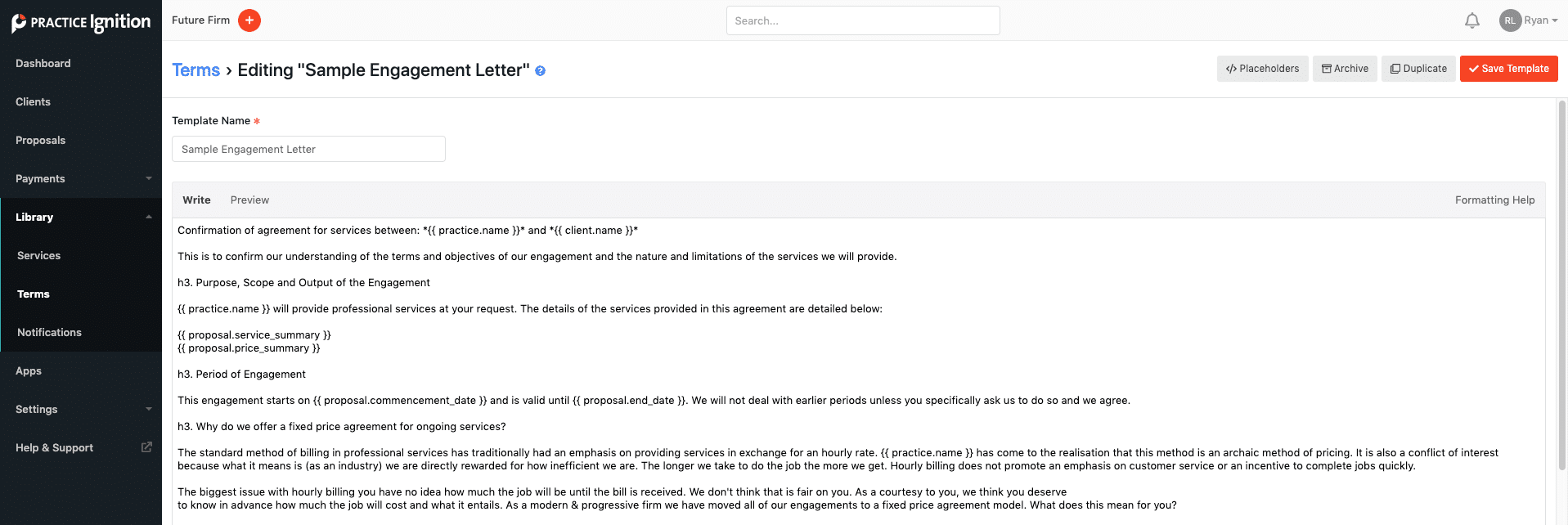
Second, I recommend setting up your services in Practice Ignition’s library. If you take a menu pricing approach, you can load your prices in here as well. Otherwise, you’ll be able to adjust the pricing in the proposal itself. Here’s an example of what it would look like when you start loading your services up:

The best part is that within each service is where you can include your standard definitions of your services, which I highlighted as exceptionally important in Step 2. When I click into the service, you’ll see a place to either include the service description, or you can add the definition in the terms tab, where all terms can appear at the bottom of your engagement letter rather than in the middle of it.

After making sure that you’re happy with the branding of your proposals with a few easy tweaks in the settings (ie. logo, colours, custom brochure, etc), you’re ready to start creating your engagement letters. If you’ve loaded up your engagement letter template and services properly into the library, creating the engagement letter literally takes seconds. The client will then receive an email once the proposal has been sent out:

They can review the services included on the right with your company’s brochure on the left:
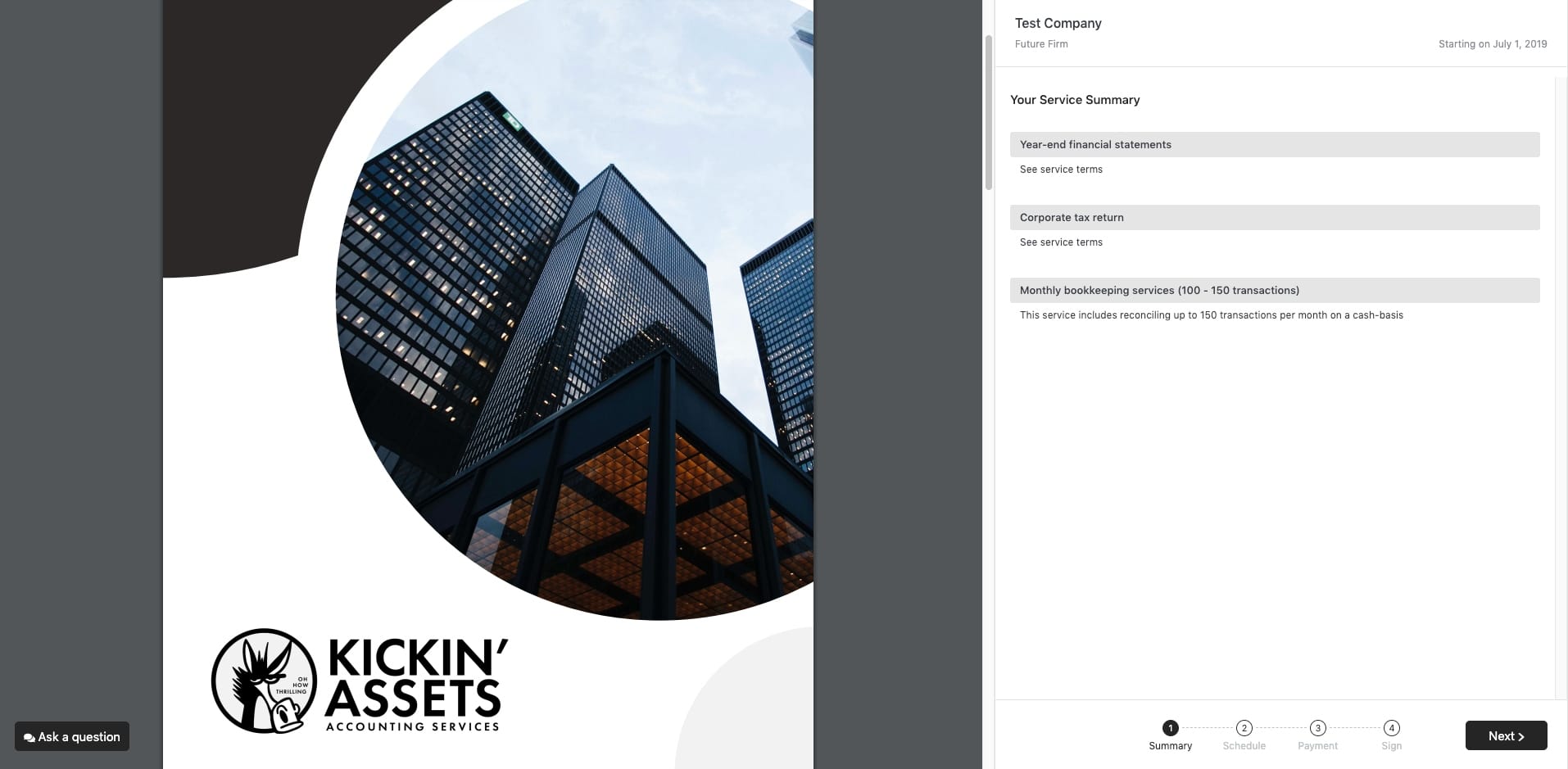
They’ll see the price and payment schedule (which is very flexible to adjust):
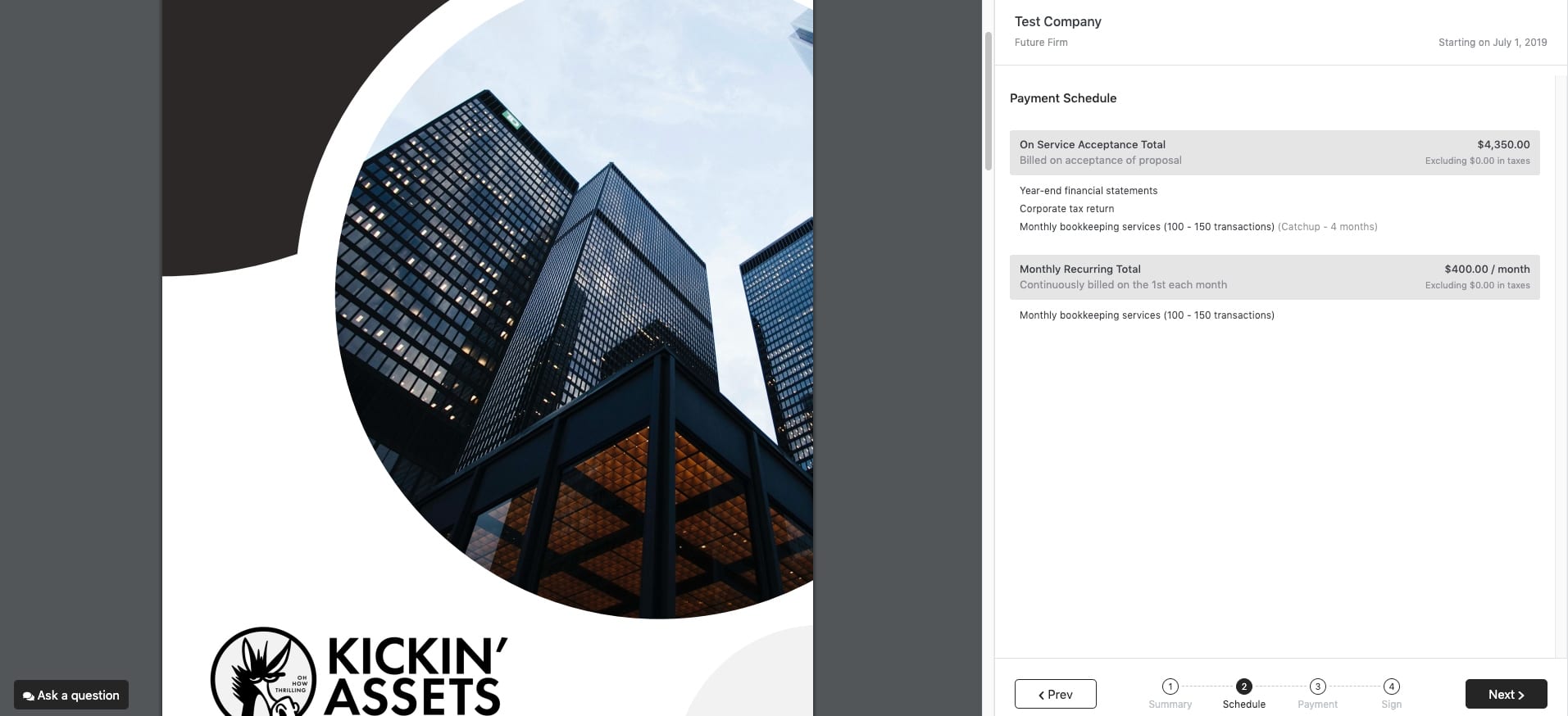
They’ll then be able to enter their payment details (credit card or pre-authorized debit, depending on what you enable) in order to automate collections of your invoices:
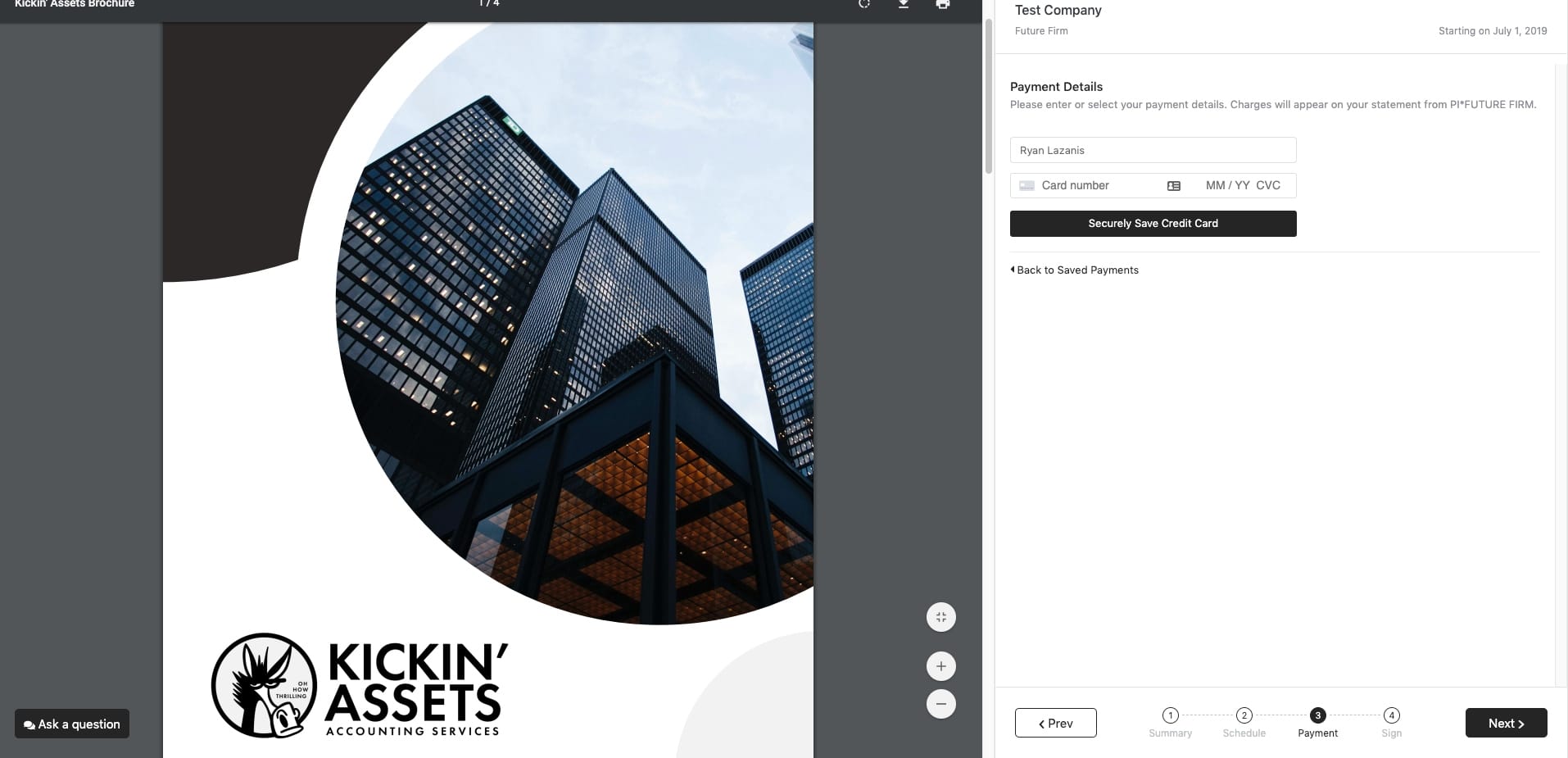
And lastly, they’ll get a view of the detailed engagement letter before they accept:
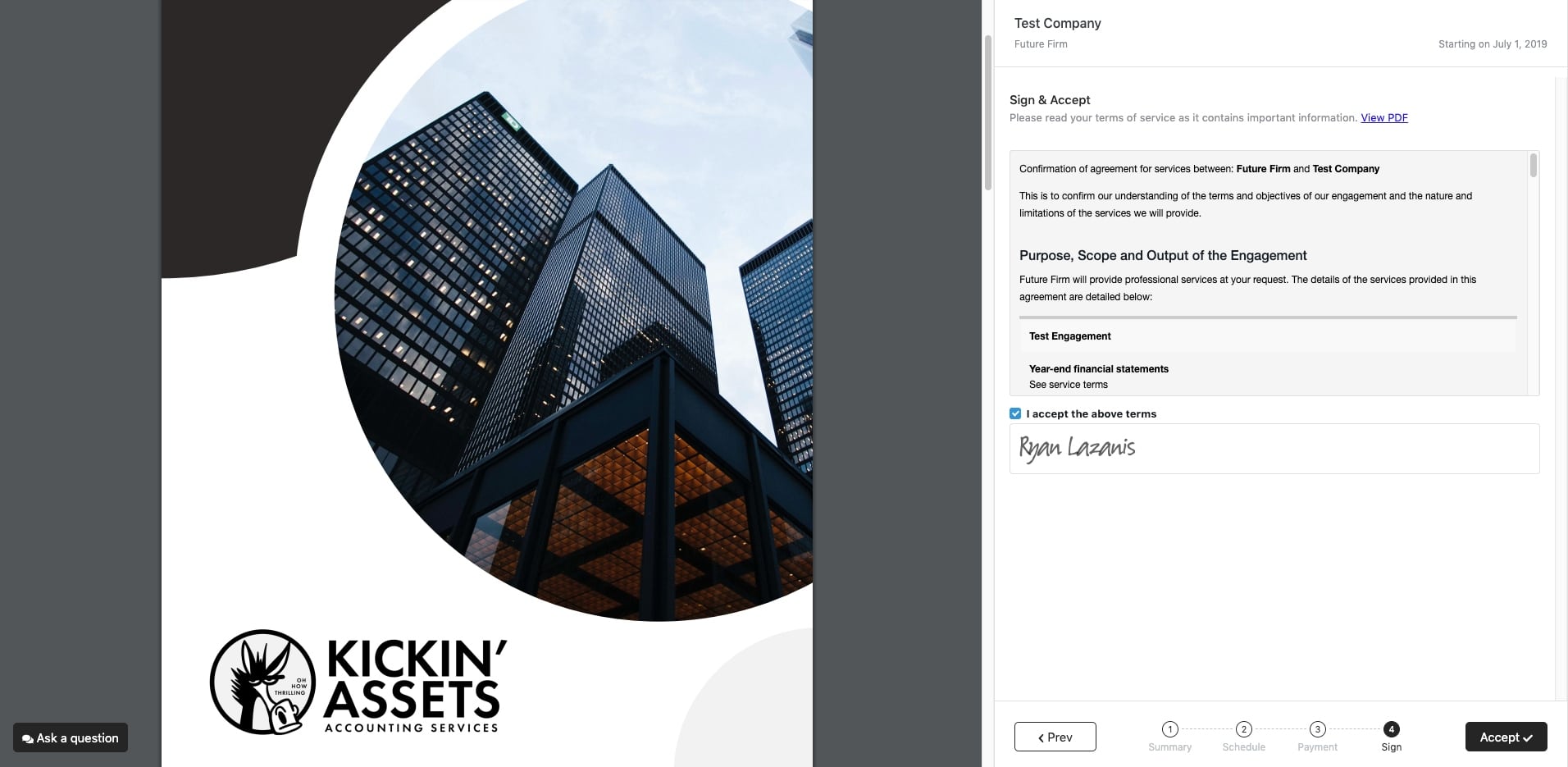
Once they accept, if you use Xero or QuickBooks Online for your own firm’s accounting, you can have all of the invoices and payments sync automatically as well. There’s also a slew of other neat features.
Personally, I’m a huge Practice Ignition fan when it comes to quickly getting detailed, well-defined engagement letters out and for helping to automate some of your back-office processes.
One thing’s for sure. Whether you use Practice Ignition or not, you’ll need some way of cementing the fixed price per month agreement.
Pricing Accounting Services Doesn’t Need to be Difficult
Hopefully, the above guide helps you in your journey in pricing accounting services and in offering upfront fixed price mandates. These methods do take some practice, but if done right, I believe it will not only improve your customer’s experience with your firm, but also help your firm avoid some of the disadvantages commonly associated with the billable hour.
What’s been your experience with fixed pricing and value pricing? Drop a comment below!





Cloud Pricing for accountants and bookkeepers. https://www.cloud-pricing-software.com/
… reason for being is to provide accounting professionals around the world with the systems and education to implement “value pricing”. A tool to make things easier when value pricing
These prices fluctuate. If you contact any freelancers they will share you with different prices.
Thank you for such thought-provoking views on accounting services.
You’re welcome 🙂
Thank you.